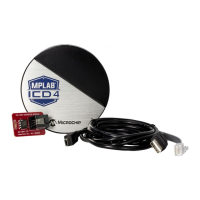MPLAB
®
ICD 4 User’s Guide
DS50002596A-page 42 2017 Microchip Technology Inc.
• What limitations are there with the standard cable?
The standard ICSP-RJ11 cable maximum clock frequency is approximately
15 MHz. Device interrogation during debugging occurs at frequencies below this
rate regardless of the CPU clock rate.
However, some advanced functions are synchronous to the CPU bus cycle (like
instrumented trace and data capture).
During data capture and when the CPU runs at its highest speed (40 MIPS for
example), the actual clock rate through the cable would exceed 15 MHz. In these
instances, trace and data capture cannot run reliably and the ICSP-RJ11 cable
cannot be used.
• Will this slow down the running of the program?
There is no cycle stealing with the MPLAB ICD 4 In-Circuit Debugger. The output
of data is performed by the state machine in the silicon.
• Is it possible to debug a dsPIC DSC running at any speed?
The MPLAB ICD 4 is capable of debugging at any device speed as specified in
the device’s data sheet.
5.3 WHAT’S WRONG?
• Performing a Verify fails after programming the device. Is this a
programming issue?
If Run Main Project is selected, the device will automatically run immediately
after programming. Therefore, if your code changes the flash memory, verification
could fail. To prevent the code from running after programming, select 'Hold in
Reset'.
• My computer went into power-down/hibernate mode, and now my debugger
won’t work. What happened?
When using the debugger for prolonged periods of time, and especially as a
debugger, be sure to disable the Hibernate mode in the Power Options Dialog
window of your computer’s operating system. Go to the Hibernate tab and clear or
uncheck the “Enable hibernation” check box. This will ensure that all
communication is maintained across all the USB subsystem components.
• I set my peripheral to NOT freeze on halt, but it is suddenly freezing. What's
going on?
For dsPIC30F/33F and PIC24F/H devices, a reserved bit in the peripheral control
register (usually either bit 14 or 5) is used as a Freeze bit by the debugger. If you
have performed a write to the entire register, you may have overwritten this bit.
(The bit is user-accessible in Debug mode.)
To avoid this problem, write only to the bits you wish to change for your application
(
BTS, BTC) instead of to the entire register (MOV).
• When using a 16-bit device, an unexpected Reset occurred. How do I
determine what caused it?
Some things to consider:
- To determine a Reset source, check the RCON register.
- Handle traps/interrupts in an Interrupt Service Routine (ISR). You should include
trap.c style code, i.e.,
void __attribute__((__interrupt__)) _OscillatorFail(void);
:
void __attribute__((__interrupt__)) _AltOscillatorFail(void);
:
void __attribute__((__interrupt__)) _OscillatorFail(void)
{
INTCON1bits.OSCFAIL = 0; //Clear the trap flag

